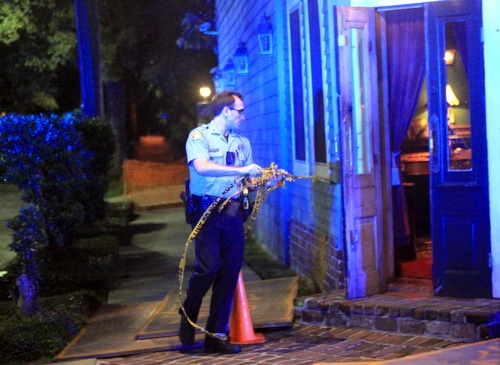
Robert Morris, Uptown Messenger file photo
(Robert Morris, Uptown Messenger file photo)
The underlying conditions that precipitated the pandemic of crime New Orleanians are facing today were centuries in the making. Hopefully, they will finally be addressed.
According to a Pew Research Center poll taken last summer, almost six out of 10 Americans believe that violent crime is a “very big problem” in the United States today.
Across the country mayors and other elected officials are already working collaboratively on solutions old and new. Many solutions harken back to an era when arresting and incarcerating perpetrators was more important than the current emphasis on such lenient policies as reduced bail, shorter sentences and more rehabilitation.
Recently elected New York Mayor Eric Adams, a former police captain, ran on a promise to make the Big Apple safe. “Public safety is my administration’s highest priority,” Adams said repeatedly. Yet New Yorkers have been besieged by several high-profile violent crimes: A woman was pushed to her death in front of an oncoming subway train by a homeless man with mental health issues. A baby was shot in the Bronx. Several police officers have been wounded or killed while on duty.
In a CNN interview Sunday (Jan. 23), Adams pledged to deal with the underlying issues that are impacting crime in New York City and has become “a stain” on the inner cities across our country. “The symbol of that soiled coat with red blood is really what we’re talking about here in not only New York City, but across America,” Adams said. He called the recent violent acts “a sea of crime fed by many rivers” and said that each river had to be dammed.
The following day Adams quickly unveiled his “Blueprint for Safety,” which includes reinstating a controversial plainclothes anti-crime unit charged with getting guns off the street. President Joe Biden will meet with Adams next week to discuss strategies to curb gun violence in New York City. In 2021, Biden announced that the federal government would allocate funding for a slate of crime-fighting initiatives.
New Orleans political leaders are counting on the city’s share of those same dollars to fund anti-crime programs. Unfortunately, New Orleans’ underlying problems go back almost 300 years, to when people of color first arrived in bondage. In a recent guest essay in The New York Times, Princeton professor and author Imani Perry called New Orleans “A crossroads and a cruel one. Waves of disaster and displacement – from chattel slavery to gentrification, from lynching to incarceration and from one terrible storm to the next – have made it a fugitive’s place.”
That “legacy of slavery” Perry talks about still haunts the city in which generations of under-educated, under-employed New Orleanians live in blighted rental properties in neighborhoods where crime is an everyday occurrence. More frequent hurricanes and street flooding — along with Covid’s effects on health, education and the economy — have only made things worse.
Do our political, business, neighborhood and civic leaders really have the public will to dissect and collaboratively address the city’s multitude of problems once and for all? Though federal dollars may be available this year for additional training for those exiting incarceration, extra social workers in juvenile court, more assistant district attorneys and crime lab staffers, and enhanced services for the homeless and those suffering mental illness, these funds will only make a temporary dent in the issues.
On June 30, 2021, just weeks before qualifying for re-election, Mayor LaToya Cantrell delivered a spirited update on how the city was coordinating with multiple agencies to reduce and prevent crime. Though Covid – not crime – was her campaign’s top priority, she needed to show leadership on this issue.
Cantrell pledged to work holistically to address what was already admitted to be a spike in crime. “This includes investing in youth, families and community leaders to reduce the number of violent incidents, arresting those who commit violent crimes and providing support and development program for both youth and adults to reduce recidivism and make our communities stronger,” Cantrell said. As crime has continued to surge in all categories, obviously her multi-agency initiative achieved only limited success during the past six months.
Any improvement in public safety must start with the New Orleans Police Department, which is suffering more than any other partner in the criminal justice system. Confidence in NOPD Superintendent Shaun Ferguson is waning among residents tired of being victimized. The federal consent decree has tied the hands of the police officers who now lack the authority and incentive — for fear of personal reprisals — to really go after suspected criminals. Officers often ride solo and do not feel safe responding to potentially dangerous 911 calls alone. No one has the officers’ backs, literally or figuratively. Morale is so low that recruitment – let alone retention – is difficult at best. Former military officers are potentially good recruits but need to be screened closely for post-traumatic stress disorder.
The recent suspension of officers accused of payroll fraud regarding off-duty details left a bad taste in many mouths. Some officers believe the department was partially responsible for the accounting problems and could have resolved the issues differently. Though NOPD salaries aren’t at the bottom of the barrel, the pay and benefits package needs to be sweetened to fill hundreds of patrol positions. Creating a non-police response for citizens with mental health issues and allowing certain city employees to have limited summons capabilities will help but cannot replace post-certified officers.
After reading Ms. Perry’s essay, it was easy to imagine the New Orleans of old where people of color built the city but were not paid for their labor, were branded with a fleur de lis when they tried to escape, and were denied the opportunity to learn to read and write. The crime rate won’t be reduced until we can change the lives of those still clinging to the bottom rungs of our laissez faire lifestyle through improved education, job training, mentoring and housing.
That’s the kind of collaborative, intergenerational, interagency plan New Orleans really needs to truly address crime and build a diversified economy that will ensure a bright future for all. Anything less will only be a stop-gap measure bound to disappoint long-term.
IS FORMER PRESIDENT TRUMP’S VISIT TO NEW ORLEANS ONLY FOR MEGA DONORS?
Local fans of Donald Trump were excited to hear that the former president will be coming to New Orleans from March 4 to March 6 to speak at a Republican National Committee event that is being organized by prominent New Orleans businessman and Republican bundler Joe Canizaro along with semi-retired shipyard owner Donald T. “Boysie” Bollinger. Sources indicate that tickets for the event will only be available for individuals who have previously donated at least $50,000 to Trump. It is not yet known whether Trump will appear at a campaign-style rally or other events during his visit.

Danae Columbus, opinion columnist
Danae Columbus, who has had a 30-year career in politics and public relations, offers her opinions on Thursdays. Her career includes stints at City Hall, the Dock Board and the Orleans Parish School Board and former clients such as former District Attorney Leon Cannizzaro, City Councilman Jared Brossett, City Councilwoman at-large Helena Moreno, Foster Campbell, former Lt. Gov. Jay Dardenne, former Sheriff Charles Foti and former City Councilwomen Stacy Head and Cynthia Hedge-Morrell. She is a member of the Democratic Parish Executive Committee. Columbus can be reached at swampednola@gmail.com.
There is a “quick” fix: All social studies teachers, in addition to others in grades 5-12, need to hammer away at the consequences of crime and the opportunities for lawful solutions to juveniles’ propensity for risk-taking and herd mentality.
An ounce of prevention is worth a pound of cure…………….
Young people need to know how criminal activities really do interfere with success in their emancipation to independent adult living and career progression. Help them understand the reasons for avoiding risky, unlawful behaviors.
I am a retired NOPS teacher……been there, done that………..